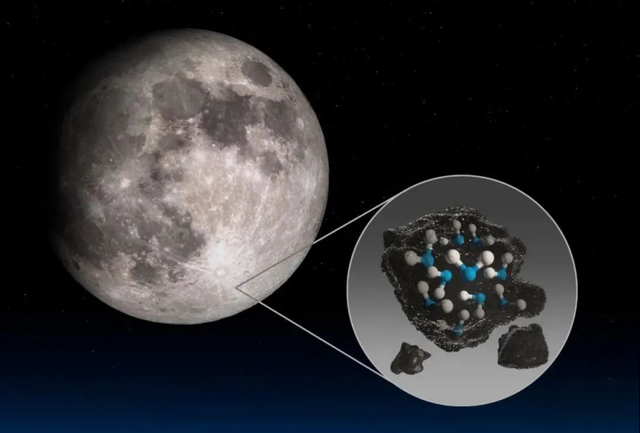(单词翻译:单击)
听力文本
Scientists: Moon Holds More Water than Ever Thought
The moon may hold water in more places and in larger amounts than scientists have suggested in the past.
The finding is based on two studies – published in Nature Astonomy — that examined new data from the U.S. space agency NASA. The discovery could be important for planned, long-term human bases on the moon. It could mean that enough resources exist on the moon itself to provide drinking water and possibly help produce rocket fuel.
Until about 10 years ago, scientists believed the moon was mostly dry. Then, a series of findings provided evidence that water ice was widespread in small amounts on parts of the moon. The ice was thought to be in areas permanently blocked from sunlight.
But in one of the new studies, NASA said it was able to confirm the presence of water molecules on sunlit parts of the lunar surface. The space agency says the identification came from data collected by its SOFIA airborne observatory. SOFIA is a Boeing 747SP aircraft equipped with a powerful telescope.
The research was led by Casey Honniball of NASA's Goddard Space Flight Center in Maryland. "Without a thick atmosphere, water on the sunlit lunar surface should just be lost to space," Honniball said in a statement. "Yet somehow we're seeing it. Something is generating the water, and something must be trapping it there."
Scientists have suggested the source of the water may have been comets, asteroids, solar wind or interplanetary dust. The new research provides evidence the water may be surviving on sunlit lunar surfaces because it is attached to minerals.
"A lot of people think that the detection I've made is water ice, which is not true," Honniball told a news conference to announce the finding. "It's just the water molecules — because they're so spread out they don't interact with each other to form water ice or even liquid water."

The second study centered on so-called "cold traps" on the moon. These are areas of the lunar surface that exist in a state of permanent darkness where temperatures are below about minus 160 degrees Celsius. Scientists say temperatures this cold can hold frozen water for billions of years.
Researchers say they were able to reconstruct the size of the cold traps and where they sit from images and temperature readings from NASA's Lunar Reconnaissance Orbiter. They identified cold traps as small as a few meters across and others as wide as 30 kilometers.
Planetary scientist Paul Hayne of the University of Colorado, Boulder led the research on cold traps. He estimated there are likely "tens of billions" of traps. "Since the little ones are too small to see from orbit, despite being vastly more numerous, we can't yet identify ice inside them," Hayne said. "Once we're on the surface, we will do that experiment."
Hayne's team says the new research suggests more than 40,000 square kilometers of the moon's surface may have the ability to trap water in the form of ice. That estimate is 20 percent bigger than predicted in the past, Hayne said.
Jacob Bleacher is the chief exploration scientist for NASA's Human Exploration and Operations Mission Directorate. He told reporters the agency believes it is very important to find out more about where the water came from and how accessible it is.
"Water is extremely critical for deep space exploration. It's a resource of direct value for our astronauts," Bleacher said. He noted that water is heavy and costly to transport from Earth.
"Anytime we don't need to pack water for our trip, we have an opportunity to take other useful items with us," he said. That may include materials that could be used to carry out bigger scientific experiments on the moon.
I'm Bryan Lynn.
重点解析
重点讲解:
1. be based on 以…为基础;
The study was based on data from 2,100 women.
这项研究基于从2,100名女性那里收集来的资料。
2. spread out 相隔很远的;分散的;
The Kurds are spread out across five nations.
库尔德人散居在 5 个国家中。
3. center on (使)以…为中心;(使)注意力集中于;
The topic centers on the crisis in these two countries.
话题以那两个国家的危机为中心。
4. carry out 实施;执行;实行;
He pledged that there would be no whitewash and that the police would carry out a full investigation.
他保证将不会有任何掩饰,并且警方将进行全面调查。
参考译文
科学家称月球上的水比我们想象中多
与科学家此前所提出的相比,月球上存在水的地方可能更多,而且含量也更大。
这一发现基于发表在《自然·天文学》期刊上的两项研究,这两项研究对美国国家航空航天局(简称NASA)的最新数据进行了审查。这一发现对于计划中的长期人类月球基地具有重要意义。这可能意味着月球本身有足够的资源来提供饮用水,可能帮助生产火箭燃料。
直到大约10年前,科学家仍认为月球大部分是干旱的。随后,一系列发现提供了证据,证明月球部分地区存在少量水冰。冰层被认为是永久性阻挡阳光的区域。
但在一项新研究中,美国国家航空航天局表示,其能够证实月球表面阳光照射的部分存在水分子。美国国家航空航天局表示,这一发现来自索非亚航空天文台收集的数据。索非亚是一架波音747SP飞机,配备了强大的望远镜。
这项研究由马里兰州的美国国家航空航天局戈达德太空飞行中心的凯西·霍尼贝尔领导。霍尼贝尔在声明中表示:“如果没有厚厚的大气层,月球表面上的水会因受到阳光照射而流失到太空中。“但是我们还是发现了水。一定有什么东西在产生水,并把水困在了那里。”
科学家认为,水的来源可能是彗星、小行星、太阳风或行星际尘埃。这项新研究提供了证据,证明水附着在矿物上时,可能存在于阳光照射下的月球表面。
霍尼贝尔在宣布这一发现的记者会上表示,“许多人认为我探测到的是水冰,但事实并非如此。我探测到的是水分子,因为它们分布得非常广,不会相互作用形成水冰甚至液态水。”
第二项研究聚焦月球上所谓的“冷阱”。这些区域是月球表面长期处于黑暗状态的区域,那里的温度低于零下160摄氏度。科学家表示,如此寒冷的温度可以使水冻结数十亿年。
研究人员表示,他们能够根据美国国家航空航天局月球勘测轨道飞行器的图像和温度读数,重建这些冷阱的大小及所在位置。他们发现了直径只有几米的冷阱,也发现了直径高达30公里的冷阱。
科罗拉多大学博尔德分校的行星科学家保罗·海恩领导了对冷阱的研究。他估计月球上可能有“数百亿”个冷阱。海恩说:“尽管小冷阱的数量要多得多,但因为过小而无法从轨道上看到,所以我们尚不能确定其内部是否有冰。登上月球之后,我们会马上进行这项实验。”
海恩的研究团队表示,新研究表明,月球上可能有超过4万平方千米的表面具有捕获水的能力。海恩说,这一比例比过去的预测高出20%。
雅各布·布朗彻是美国国家航空航天局人类探索和行动任务理事会的首席探索科学家。他对记者表示,该机构认为,了解这些水的来源以及可利用程度的更多信息非常重要。
布朗彻表示,“水对深空探测至关重要。这对我们宇航员来说是直接资源。”他指出,从地球上运输水耗力又耗钱。
他说:“如果我们不需要为旅行打包水,那我们就有机会随身携带其他有用的物品。”这可能包括可用于在月球上进行更大科学实验的材料。
布莱恩·林恩报道。
译文为可可英语翻译,未经授权请勿转载!


